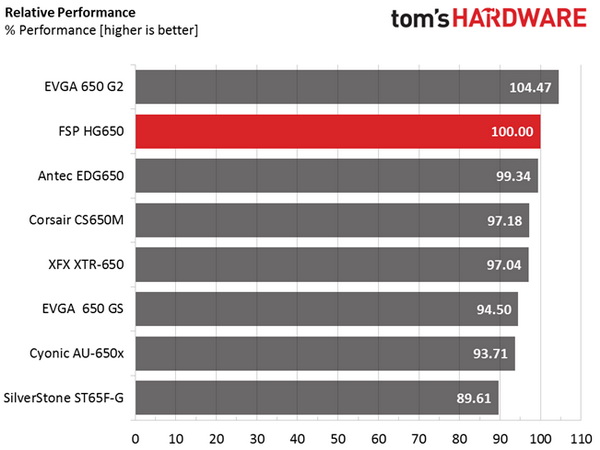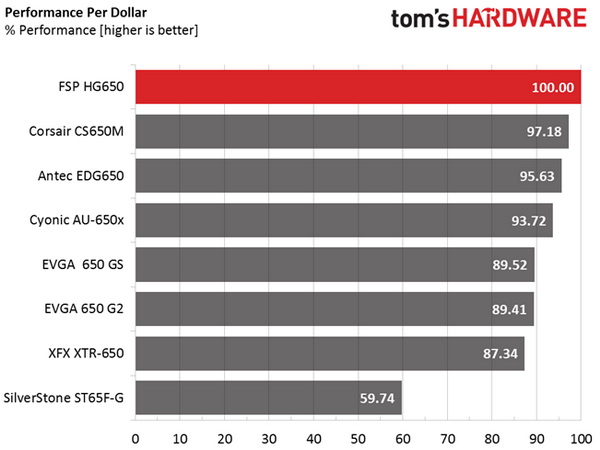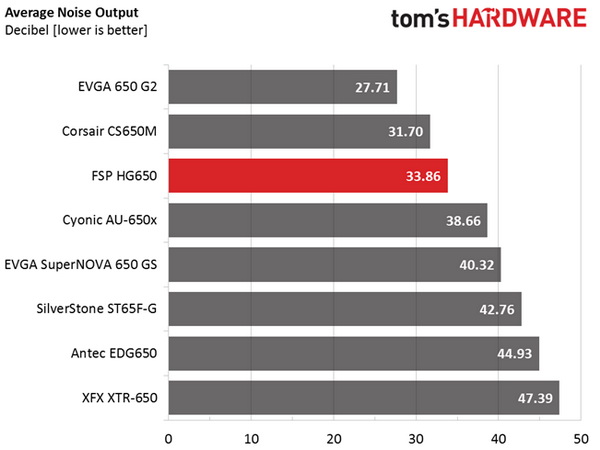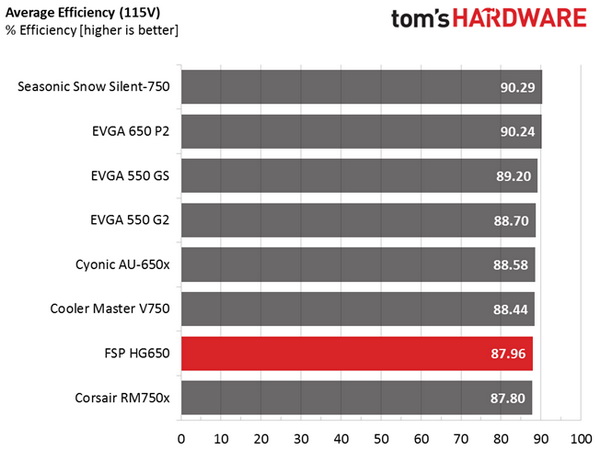FSP Hydro G 650 Power Supply Review
FSP recently released a new PSU platform that mostly addresses gamers. The Hydro G line includes three units, and today we're testing the 650W version. The PSU is 80 Plus Gold certified and features fully modular cabling. Let's see how it performs.
Why you can trust Tom's Hardware
Performance, Performance Per Dollar, Noise and Efficiency Ratings
Performance Rating
The following graph shows the total performance rating of the PSU, comparing it to other units we have tested. To be more specific, the tested unit is shown as 100 percent, and every other unit's performance is shown relative to it.
The Hydro G 650 only loses to EVGA's SuperNOVA 650 G2, which is based on the amazing Super Flower Leadex platform. However, if you are looking for something different and with a nice look, then FSP's offering is a fine choice.
Performance Per Dollar
The following chart may be the most interesting to many of you because it depicts the unit's performance-per-dollar score. We looked up the current price of each PSU on popular online shops and used those prices and all relative performance numbers to calculate the index. If the specific unit wasn't available in the United States, we searched for it in popular European Union shops, converting the listed price to USD (without VAT). Note that all of the numbers in the following graph are normalized by the rated power of each PSU.
As you can see, the HG650 finishes in first place among comparable PSUs. The higher price of EVGA's 650 G2 places it way below the Hydro G 650.
Noise Rating
The graph below depicts the cooling fan's average noise over the PSU's entire operating range, with an ambient temperature between 28 and 30 °C (82 to 86 °F).
Besides good performance and an affordable price, the Hydro G 650 is also quiet enough to meet the demands of most enthusiasts. Corsair's and EVGA's offerings do offer even quieter operation, though. The 650 G2 fares best mostly because of its long-lasting passive mode.
Efficiency Rating
The following graph illustrates average efficiency throughout the PSU's entire operating range, with an ambient temperature between 28 °C and 30 °C.
Get Tom's Hardware's best news and in-depth reviews, straight to your inbox.
With 115V input the HG650 isn't as efficient as with 230V. However, it still manages to stay close to 88 percent.
Current page: Performance, Performance Per Dollar, Noise and Efficiency Ratings
Prev Page Ripple Measurements Next Page Pros, Cons And Final Verdict
Aris Mpitziopoulos is a contributing editor at Tom's Hardware, covering PSUs.
-
Onus I see a Performance Per Dollar chart, but so far I've not been able to find the price of this unit. What is it?Reply
-
Aris_Mp ReplyI see a Performance Per Dollar chart, but so far I've not been able to find the price of this unit. What is it?
It is 90 bucks
http://www.newegg.com/Product/Product.aspx?Item=N82E16817104200&nm_mc=AFC-C8Junction&cm_mmc=AFC-C8Junction-VigLink2-_-na-_-na-_-na&cm_sp=&AID=10446076&PID=3821802&SID=il40akd6as0035wt00053 -
mrjhh I remember FSP being an OEM for older computer vendors like DEC, so they definitely aren't a newcomer to the field. I'm glad to see they know how to build a modern supply.Reply -
Onus IMHO FSP has always had a solid but "middle-of-the-pack" reputation; not anybody's first choice, but a lot better than a lot of the junk being sold. Even their Raider units that got very critical reviews were acceptable as budget units in light use. In big box PCs, I'd certainly rather see FSP than HEC or Bestec.Reply
-
jeffunit I see "op amp amplifier" mentioned several times in the review.Reply
What is an "op amp amplifier"
Doesn't amp stand for amplifier in this context, which expands to op amplifier amplifier?
-
Odd naming scheme for a power supply. Hope it doesn't confuse anyone into thinking water goes well with it. :PReply
Always good to see some of the larger if less well known manufacturers putting out quality units. -
jeffunit ReplyWhat is an "op amp amplifier"
short for operational amplifier
op amp is short for operational amplifier.
op amp amplifier is short for operational amplifier amplifier.
You need to pay more attention to what is written. -
turkey3_scratch Good performing power supply. In terms of voltages and ripple, beats the EVGA GS. I would never hesitate to recommend this unit, if it is priced well of course, which it already is not.Reply



